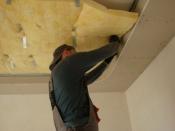Search
Login
Drop watering in a greenhouse, how to make drop watering yourself
In order for the plants in the greenhouse to please their good development and rich harvest, they need absolutely nothing - heat and light, which give the sun's rays, and moisture. To make systematic irrigation manually, to strictly dose the amount of water consumed is a rather laborious task and requires considerable time. In addition, if the greenhouse is located on a suburban area, then it is often not always possible to visit it. It is for these reasons that the owners of greenhouses have to engage in inventive activity and go to all sorts of tricks that allow constructing original irrigation systems from improvised means. It should be noted that they sometimes do not require a water supply system for their work or do not consume electricity, but they are no less reliable than those that are purchased ready-made.
Content:
- The advantages of drip irrigation video
- The principle of the drip irrigation system in the greenhouse
- Designing a drip irrigation system for a greenhouse video video
- Drop watering in a greenhouse and equipment that will be needed to equip it
- Water source for drip irrigation system
- Starting the drip irrigation system
- Planting plants
The advantages of drip irrigation

All automatic irrigation systems used today can be divided into sprinkling, subsoil moisture application and drip irrigation. If sprinkling has a significant drawback consisting in the subsidence of water droplets on the leaves, then with automatic drip irrigation of the greenhouse moisture gets directly to the roots of the plants and is fully used by them. The drip irrigation system can consist of hoses located both in the soil and on its surface, any method will give the plants enough moisture to grow. Drop watering for the greenhouse will help to protect the plants in case of freezing - this will contribute to soil moisture.
When growing annuals of large sizes in greenhouses, it is almost impossible to manage without drip irrigation. Drop watering is indispensable even in the case when you have to use the water of their small containers. To create a system, an ordinary barrel located at a height of one and a half meters above the beds will be enough. Hoses that are used for drip irrigation can work at low pressure in the system and a small amount of water in it.
Using modern irrigation systems makes it possible:
-
significantly increase the efficiency of fertilizers applied to the soil,
-
to improve the quality of the grown products and their quantity,
-
reduce the risk of plant disease,
-
keep the soil around the plants in a light, well-ventilated condition,
-
get rid of the active growth of weeds.
The drip irrigation device in the greenhouse allows you to avoid the appearance of burns on the leaves, which appear from drops of water deposited on the leaves during normal watering. The soil gets a fairly deep moisture when drip irrigation, with normal - moisture penetrates only 10 cm, forming puddles on the surface.
The principle of the drip irrigation system in the greenhouse

For growing plants in a greenhouse, it is very important that water enters the soil exclusively around the rhizome of plants, this contributes to the local development of the root system - it does not grow on the side of drier areas. This point is quite important in the greenhouse. Each plant receives an individual portion of water, depending on individual needs, periodically or continuously.
The flow of water through the pipes of the system is slow, the water has time to warm up sufficiently. An optimum humidity level and a sufficiently high temperature make it possible to create a climate in the greenhouse similar to subtropical, allowing fruiting to be obtained all year round.
Designing a drip irrigation system for a greenhouse
In order to correctly calculate the drip irrigation system, it will be necessary to draw up a detailed planting plan, taking into account the length of the row, the distance between the rows and their length. The type and variety of plants are also taken into account - the drip irrigation of tomatoes in the greenhouse will differ from that required for cabbage or cucumbers, it will be necessary to create a self-irrigation subsystem separately for each crop.

The calculation is made in accordance with the following standards: for normal development and fruiting, each tomato bush per day will need 1.5 liters of water. If the nozzle in the drip irrigation system can deliver 1.15 liters of water per hour, then the automatic watering of the tomato should last 1 hour 20 minutes a day. The interval between the nozzles should be 30 cm - with such a frequency, it is recommended to plant tomato bushes in a row.

For irrigation of cucumbers, 2 liters of water per day will be required, with the same nozzle performance, the system will require operation for 105 minutes. The interval between nozzles should be 20 cm. Seeds of cucumbers are sown or their seedlings are planted after assembling the irrigation system.
It is recommended to plant cabbage in a greenhouse at a distance of 40 cm from each other, nozzles should be placed with the same frequency. The norm of irrigation is 2.5 liters of water, the irrigation time per day will be 2 hours 10 minutes.

Knowing the number of planted plants, the norms of water consumption and the time to water each species, calculate the total amount of water. Having determined the total amount of fluid required, the automatic mode of its supply is calculated. The best option is the water supply of their tank, the water will be automatically distributed between different subspecies of the irrigation system.
Drip irrigation in the greenhouse and equipment that will be needed to equip it

When installing the irrigation system, use a hose made of polyethylene or PVC with a diameter of 10 to 15 mm, black (this will prevent the growth of algae in it). Due to the small diameter of the hose, the water in it will move slowly and create the pressure necessary for watering. It is recommended to use hose sections from 6 to 8 m long. When arranging drip irrigation with your own hands, you can use the details of medical droppers as nozzles. They are established with a certain frequency, depending on the type of plants.
You can also use watering tape purchased at the store in the finished form. For irrigation of cucumbers, carrots or beets, you should use a tube with holes after 15 cm, for tomatoes - after 30. In a purchased tube with a diameter of 16 mm, each nozzle can pass about 1 liter of liquid for an hour, irrigating the soil in a radius of 20 cm. In this case, the task of assembling an automatic irrigation system is extremely simplified.

To fix the tubes, fittings are used - short plastic tubes with a thread cut on one side, and a nut and rubber seal on the other. Fittings with taps are sometimes used. They will be needed when designing an automatic system for watering plants with different needs. Also, the creation of the system involves the use, if necessary, of taps, plugs, connecting elements, seals, elbows, clamps and other elements.

If the hose will be connected to the pipeline, you will need to drill a hole in it, insert the seal first, then the fitting. The pipe is laid across the beds. All fittings are fixed in one plane, watering hoses are connected to them.
Water source for drip irrigation system

As a source of water, you can use any container of sufficient volume, equipped with a valve. Place it at a height of 2 - 2.5 m above the ground. It is advisable to use water from a well, but not from a natural reservoir or water supply system. To prevent clogging of nozzles and clogging of hoses with algae, water from natural reservoirs should be cleaned with a filter system. It is worth noting that they have a considerable price. Sometimes it is easier to resort to replacing damaged parts of the system. It is recommended to filter and defend water from the water supply.
Starting the drip irrigation system
After assembling all parts of the system, it is tested by blowing all nozzles and hoses under maximum pressure. They also make sure that there are no foreign objects in the system - they can contribute to the failure of the entire system. Installation of an automatic irrigation system can be performed at a height of 15 to 20 cm above the ground. In this case, the owners get the opportunity to control the irrigation process and eliminate the problems that arise in it. Pressure adjustment can be done by tilting the system elements.
Planting plants

Planting plants is recommended after the assembly of the system, in the immediate vicinity of the nozzles. Small plants can be planted in groups. It is recommended to mulch the soil. The mulch should have a thickness of 3-5 cm, you can also use a mulching double-sided PVC film. Its white side serves as a backlight and increases the process of photosynthesis, the bottom, black, prevents moisture evaporation, keeps the soil in a loose state, inhibits the growth of weeds. A greenhouse with a self-made drip irrigation system will make it possible to get a high crop of vegetables.





